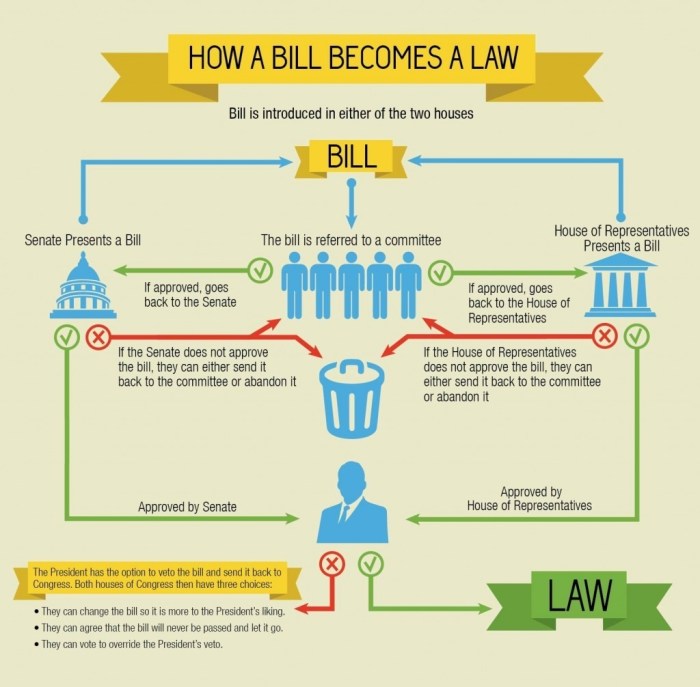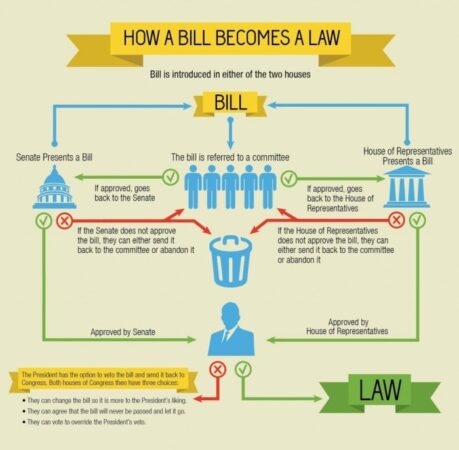
Who sign bills to become laws – Who signs bills to become laws? In the United States, this pivotal role belongs to the President, the head of the executive branch. The President acts as the final gatekeeper for legislation, wielding the power to shape the nation’s laws through their decisions on bills passed by Congress.
The process of a bill becoming law is complex, involving multiple steps and actors. It begins in either the House of Representatives or the Senate, where members debate and amend the proposed legislation. Once a bill passes both chambers, it reaches the President’s desk. The President then has the power to sign the bill into law, veto it, or allow it to become law without a signature. Each of these actions has significant consequences for the legislation and the nation.
The Role of the Executive Branch

The President of the United States plays a crucial role in the legislative process, specifically in the final stage of a bill becoming a law. The President has the power to either approve or reject a bill passed by Congress.
The President’s Actions on a Bill
The President’s actions on a bill can have significant consequences, shaping the course of legislation and impacting the nation. The President has three options:
- Signing the Bill: This action signifies the President’s approval, and the bill becomes law. This is the most common outcome, as it reflects a consensus between the legislative and executive branches.
- Vetoing the Bill: The President can reject a bill by issuing a veto. This action sends the bill back to Congress with a written explanation of the reasons for the veto. Congress can override the President’s veto with a two-thirds majority vote in both the House and the Senate. This process highlights the principle of checks and balances, allowing Congress to potentially overrule the President’s decision.
- Allowing the Bill to Become Law Without a Signature: If the President takes no action within 10 days of receiving a bill (excluding Sundays), the bill automatically becomes law without the President’s signature. However, this only applies if Congress is in session. If Congress is not in session, the bill is considered “pocket vetoed” and does not become law.
Outcomes of the President’s Actions
The President’s actions on a bill have distinct outcomes:
- Signing the Bill: The bill becomes law and is implemented by the relevant government agencies. This action reflects the President’s agreement with the legislation and its potential to benefit the nation.
- Vetoing the Bill: The bill is rejected and does not become law. This action signifies the President’s disagreement with the legislation and its potential impact on the nation. The President’s veto can be overridden by Congress, demonstrating the balance of power between the branches.
- Allowing the Bill to Become Law Without a Signature: The bill becomes law without the President’s explicit approval. This action can be seen as a neutral stance, allowing the legislation to take effect without the President’s active endorsement.
The Legislative Process

The legislative process in the United States is a complex and multifaceted system designed to ensure that laws are carefully considered and debated before they are enacted. It involves the House of Representatives, the Senate, and the President, each with distinct roles and responsibilities.
This process begins with the introduction of a bill, which is a proposed law, and ends with the President’s decision to sign or veto it.
The Steps of the Legislative Process
The legislative process is a multi-step journey that a bill must navigate before it can become law. The process begins in either the House of Representatives or the Senate, and it involves several key stages, each with its own set of rules and procedures.
- Introduction: A bill is introduced by a member of Congress and assigned to a specific committee based on its subject matter.
- Committee Review: The assigned committee reviews the bill, holds hearings, and may amend it before sending it to the floor of the House or Senate.
- Floor Debate: The bill is debated by members of the House or Senate, and amendments can be proposed and voted on.
- Vote: If a bill passes a vote in the House or Senate, it is then sent to the other chamber for consideration.
- Conference Committee: If the House and Senate versions of the bill differ, a conference committee is formed to reconcile the differences and create a single version.
- Final Vote: The reconciled bill is then voted on again by both the House and Senate.
- Presidential Action: If the bill passes both chambers, it is sent to the President. The President has the power to sign the bill into law, veto it, or allow it to become law without a signature after ten days.
Key Stages for Amendment or Rejection, Who sign bills to become laws
Several key stages in the legislative process present opportunities for a bill to be amended or rejected:
- Committee Review: Committees can significantly alter a bill’s content, and they can choose to reject a bill entirely.
- Floor Debate: Amendments can be proposed and voted on during floor debate, potentially changing the bill’s original intent.
- Conference Committee: The conference committee can significantly alter the bill’s content during the reconciliation process.
- Presidential Action: The President’s decision to sign or veto a bill is the final stage of the legislative process, and it represents the ultimate opportunity for rejection.
Epilogue: Who Sign Bills To Become Laws

The process of enacting laws in the United States is a testament to the delicate balance of power between the executive, legislative, and judicial branches. The President’s role in signing bills into law is crucial to this system, reflecting the checks and balances that ensure no single branch holds absolute authority. Understanding the President’s power and the intricate legislative process is essential for informed citizens and active participants in our democracy.
Frequently Asked Questions
What happens if the President doesn’t sign a bill within 10 days?
If the President doesn’t sign a bill within 10 days of receiving it, it automatically becomes law unless Congress adjourns before the 10 days are up. This is known as a “pocket veto.”
Can the President change a bill before signing it?
No, the President cannot change the content of a bill. They can only choose to sign it, veto it, or allow it to become law without a signature.
What are some historical examples of significant presidential vetoes?
Some notable examples include President Andrew Jackson’s veto of the Bank of the United States recharter in 1832, President Franklin D. Roosevelt’s veto of the Bonus Bill in 1933, and President Lyndon B. Johnson’s veto of the Civil Rights Act in 1964.
